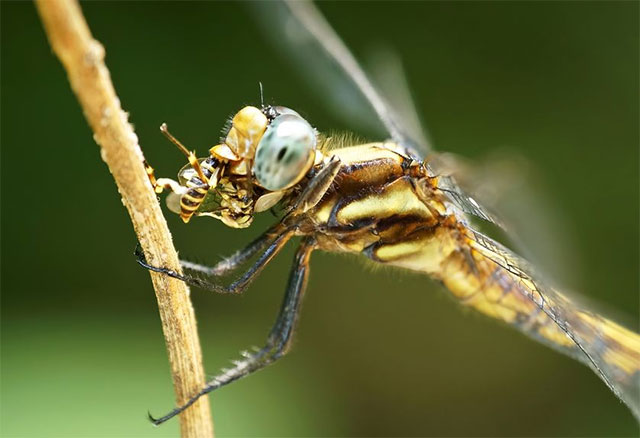6 things you never knew about dragonflies
Dating back over 300 million years, dragonflies are one of the first insects to inhabit the planet. They have had a long enough period of time to perfect their 'flying' art of excellence, their excellent hunting skills and become interesting insects of the natural world.
Dragonflies are distributed almost everywhere in the world, especially hot and humid tropical areas, and are animals familiar to humans. However, in reality, there are still many things about dragonflies that we have never known.
Here are 6 facts that many people have never known about the unique, ancient and extremely diverse insect species.
Dragonflies can catch prey in midair
 A dragonfly is enjoying a protein-rich meal
A dragonfly is enjoying a protein-rich meal Assuming you're a small insect, such as a mosquito, encountering dragonflies would be your worst nightmare. Not only is the dragonfly's superior size, the airborne hunting skill is also classified as the upper hand in the insect world.
They can capture their prey with highly calculated and extremely scientific aerial ambushes. The dragonfly can judge the speed and trajectory of the prey and adjust its flight speed / trajectory to capture the prey alive. The success rate of dragonfly hunting is up to 95%.
Dragonfly - the creepiest 'butcher' of the insect world
 Dragonfly is a perfect hunting machine
Dragonfly is a perfect hunting machine Besides impressive hunting techniques, the ability to tear off the prey of a dragonfly is also extremely frightening.
When hunting, dragonflies catch and hold their prey with their feet, tearing off their prey with sharp jaws so that they cannot escape and start the meal immediately - all done in the air.
Surplus flying ability
 Each wing of the dragonfly can operate independently
Each wing of the dragonfly can operate independently Talking about the ability to fly, not many species in the animal kingdom can be compared to dragonflies. They have two extremely thin wings but are controlled by very strong muscle fibers in the chest. This allows them to fly in any direction, both horizontal and backward, as well as being able to stand still in a single position in the air for a minute or more. This astonishing ability is a factor that contributes to their impressive success in hunting - simply striking from any direction.
Speed and endurance are also respectable factors of this animal. They can fly at a maximum speed of 29km / h, during long trips to over 17,000km.
The dragonfly's head is almost covered with eyes
 Dragonflies have nearly 360-degree vision
Dragonflies have nearly 360-degree vision The area of the head of a dragonfly is mostly covered with giant paired eyes, with a total of nearly 30,000 small faces. Each of these eyes gives them a bit of information about their surroundings.
Dragonflies have nearly 360-degree vision, only a single blind spot is right behind them. The extraordinary vision is one of the reasons why these insects almost never collide while flying, and help them detect enemies as well as prey from all directions.
Dragonflies live for about 2 years underwater
 Dragonfly larvae
Dragonfly larvae Dragonflies lay eggs in water and when the larvae hatch, they stay underwater for up to two years. In fact, depending on altitude and latitude, some dragonfly species can be in larval states for up to 6 years. They will molt up to 17 times until they grow up and turn into the dragonflies we see in the air.
During the larval stage, they are especially adapted to aquatic life, typically the ability to catch prey at an extremely fast pace. The menu of dragonfly larvae is quite diverse, they eat insect larvae (including their fellow), tadpoles and even fish - as long as they 'fit'!
Some dragonflies lay their eggs in salt water
Very few insects can lay eggs in salt water, except for some dragonflies, such as the sea dragonfly Erythrodiplax berenicei. They can reproduce successfully in water with high salinity.
This extraordinary ability of Erythrodiplax berenicei has evolved over millions of years, because its habitats are mainly salt marshes, mangroves and salt lakes.
You should read it
- Popular dragonflies in Vietnam
- 530 million year old fossils have eyes like bees, dragonflies today
- New discovery: Dragonfly wings can kill bacteria without antibiotics
- What is the Deep Web? Unknown secrets about the Deep Web
- Review HP Elite Dragonfly (2020): Premium recycling version
- Is egg yolk really beneficial or harmful?
- 8 habits when processing eggs harmful to health you need to quit immediately
- Is eating raw eggs beneficial or harmful?
- How long can eggs stay fresh? How to best preserve eggs?
- Need to be careful when using eggs
- The mysteries in video games seem to be buried forever
- Boiling eggs with a microwave may explode, why?
May be interested

This chimpanzee population has a hobby of throwing rocks at trees and the mysterious reason behind it

List of 24 endangered animals in the last 10 years

10 most exotic waterfalls in the world

19 interesting things about hummingbirds, the only flying bird on Earth

9 astonishing facts about dolphins

The series of photos shows the natural world with many things we don't know






 Things You Never Knew About Dragonflies
Things You Never Knew About Dragonflies 27 things I wish I knew before programming
27 things I wish I knew before programming 530 million year old fossils have eyes like bees, dragonflies today
530 million year old fossils have eyes like bees, dragonflies today Popular dragonflies in Vietnam
Popular dragonflies in Vietnam Tips to play Sky: Children of the Light gamers need to know
Tips to play Sky: Children of the Light gamers need to know Discover the mystery of dangerous chemical weapons in ancient war
Discover the mystery of dangerous chemical weapons in ancient war